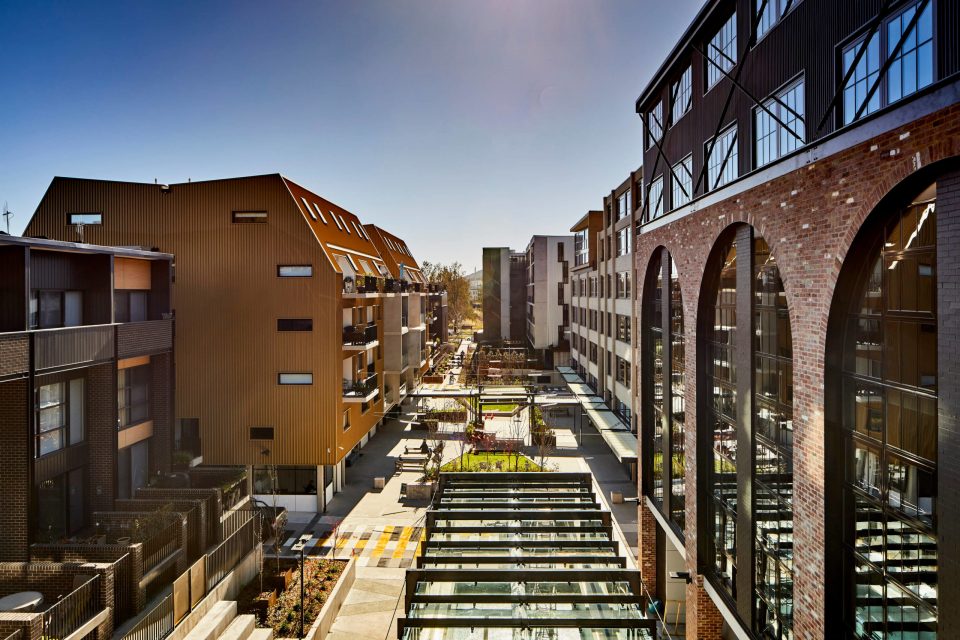
The Japanese-inspired perfectly-balanced House for Hiroko took home the main prize. Photo: Regina Seelig.
While it was a Japanese-inspired home in O’Connor that took out the top gong at last week’s ACT Architecture Awards, Canberra’s iconic bus shelters also scored a nod in the enduring architecture category. However, the big winner on the day was most definitely Canberra’s unique blend of sustainability, residential and heritage.
Jury Chair Cassandra Keller said a common theme to this year’s entries was the importance of the feeling of home after so many people had spent so long there last year.
“The COVID-19 pandemic puts the quality of our lived spaces into the spotlight like never before,” she said.
The judging panel was unanimous in picking House for Hiroko by Anthony Knobel Architect as the recipient of the Canberra Medallion and the Malcolm Moir and Heather Sutherland Award for Residential Architecture – Houses (New).
This balanced home is set around a central dining and cooking space which serves as the heart and soul of the property. The jury commented that the house is effortless, domestic and refined.

Outdoors can easily come indoors here. Photo: Regina Seelig.
Mr Knobel said he thought there was a lot of relevance in a residential property winning an architectural prize in this day and age when home has become a refuge.
Like a traditional Japanese residence, the home can be opened to invite the garden indoors and the jury remarked that it was a fitting tribute to a life lived abroad.
“Hiroko’s House has a huge sense of place,” Mr Knobel said.
SL House in Aranda from Ben Walker Architects Pty Ltd was also recognised as sympathetic to its urban and natural environment.
Another highly-awarded home was Little Loft House by Light House Architecture and Science which revived both The Gene Willsford Award for Residential Architecture (Alterations & Additions) and The Derek Wrigley Award for Sustainable Architecture.

The Little Loft House was highly awarded for using what was already there. Photo: Ben Wrigley.
The judging panel said the home had seized the opportunity to turn the suburban archetypal 1980s home into a modern, sustainable home using practical energy-efficient technologies like rainwater harvesting, recycled materials and all-electrical appliances.
Project architect Duncan Hall said he embraced the challenge of taking the value that was already in the built fabric of the home and refitting it, rather than doing a knockdown-rebuild.

These iconic bus shelters were recognised. Photo: Ken Charlton.
Architect Clem Cummings’ space-age bus shelters were recognised with The Sir Roy Grounds Award for Enduring Architecture. There are now 480 of these iconic bush shelters around town, which Cummings had originally envisaged as a functional way of connecting Canberra back in 1974.
In terms of public buildings, the new ACT Government office building in Dickson, Northbourne Avenue by Bates Smart, won The John Andrews Award for Commercial Architecture for its role marking, “the regeneration of both the Dickson precinct and Northbourne Avenue corridor”.
Stromlo Pool, Brindabella Carpark and Verity Lane Market all received commendations.






The awards also recognised public art with Murmuration – Art Installation by Daryl Jackson Alastair Swayn being applauded as “an example of public art that brings significant value to its immediate setting through active engagement with the site and those who move through it”.
Buildings at the ANU and UC were commended while Burgmann Anglican School’s Early Learning Centre took out a prize.
The awards also recognised individuals in the field with Clare Cousins who acted as a spokesperson for the #HandsOffAnzacHall campaign awarded the highest honour, the President’s Medal.
DNA Architects director Ajanthan (AJ) Bala received the Professional Practitioner Award while the Emerging Architect Prize went to SQC Architecture principal Sander de Vries.
Students from UC also had their achievements recognised.
The ACT Award winners will now go on to compete in the National Architecture Awards program once all other state and territory winners have been announced.















